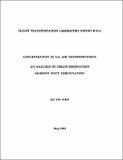Concentration in U.S. air transportation : an analysis of origin-destination markets since deregulation
Author(s)
Van Acker, Jan
DownloadFTL_R_1991_02.pdf (6.580Mb)
Alternative title
Concentration in US air transportation : an analysis of origin-destination markets since deregulation an analysis of origin-destination markets since deregulation
Concentration in United States air transportation : an analysis of origin-destination markets since deregulation an analysis of origin-destination markets since deregulation
Analysis of origin-destination markets since deregulation an analysis of origin-destination markets since deregulation an analysis of origin-destination markets since deregulation
Other Contributors
Massachusetts Institute of Technology. Flight Transportation Laboratory
Metadata
Show full item recordAbstract
The thesis examined the effects on competition of deregulation in the airline industry by analyzing changes in concentration over the ten-year period 1979-1989 in two sets of origin-destination city-pair markets: the top 100 markets in which the most passengers traveled in 1989, and the top ten markets to and from each of fifteen dominated cities. Concentration levels were significantly lower in the top 100 markets in 1979 than in 1989. Average concentration levels in the 150 markets out of the dominated cities were only slightly lower in 1989 than in. 1979. In both sets of markets average concentration decreased from 1979 to 1985. From 1985 to 1989, it increased slightly in the top 100 markets, and it increased significantly in the 150 markets out of the dominated cities. The hub-and-spoke route structure developed by all major airlines was the primary cause for the decrease in concentration levels in most of the markets. In the markets out of the hub airports, the development of the hub by a single airline led to an increase in competition in the period 1979-1985, as this airline began to compete against incumbent carriers in those markets. After 1985, however, the hub airlines became gradually dominant in the markets out of their hub airports, prompting many to ask for re-regulation of some kind. This would probably not increase competition in the dominated cities' markets, however, and would very likely adversely affect competition in the overall air transportation system.
Description
May 1991 Also issued as an M.S. thesis, Massachusetts Institute of Technology, Dept. of Electrical Engineering and Computer Science, and Sloan School of Management, 1991 Includes bibliographical references (p. 131-132)
Date issued
1991Publisher
Cambridge, Mass. : Flight Transportation Laboratory, Dept. of Aeronautics and Astronautics, Massachusetts Institute of Technology, [1991]
Other identifiers
24101868
Series/Report no.
FTL report (Massachusetts Institute of Technology. Flight Transportation Laboratory) ; R91-2
Keywords
Airlines, Aeronautics, Commercial, Deregulation, Management, United States, United States